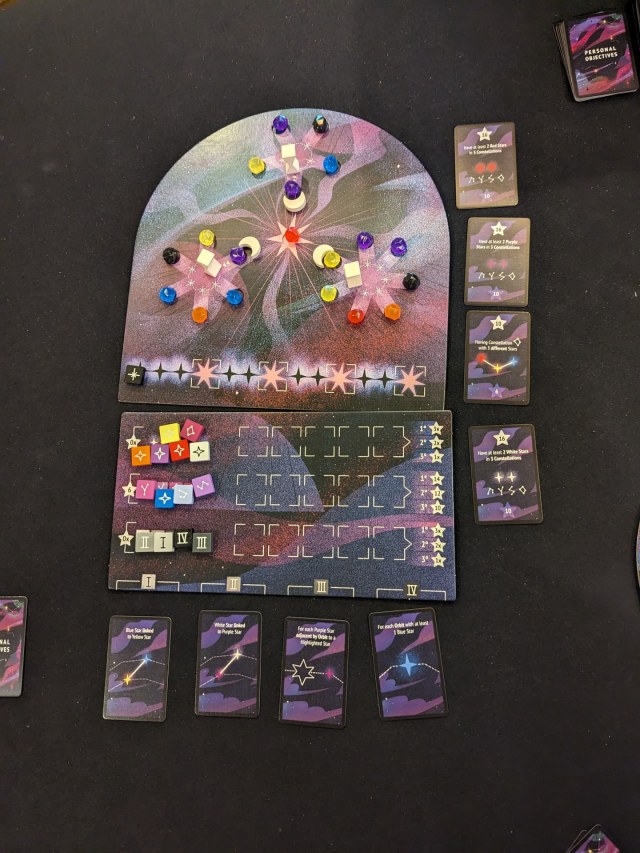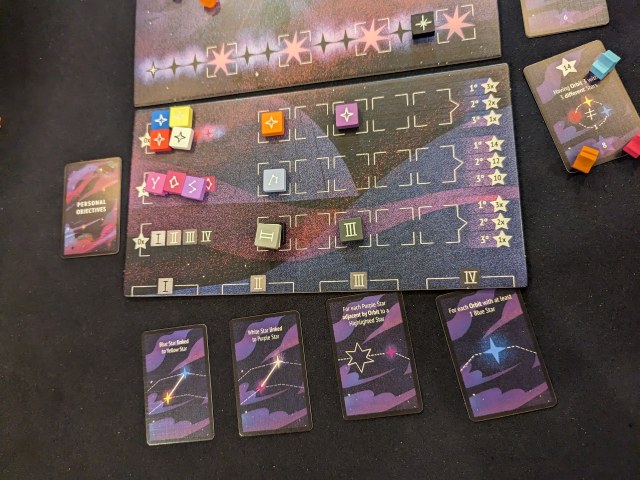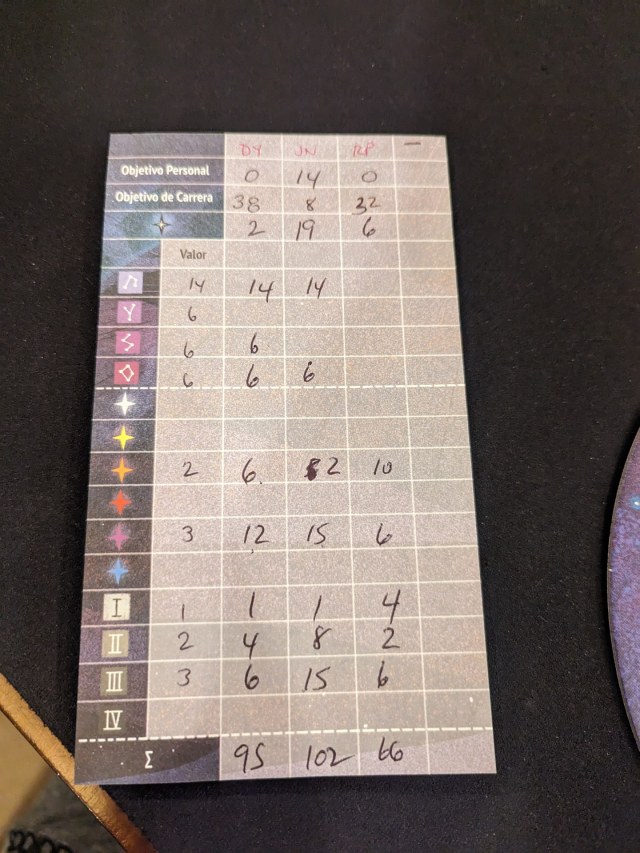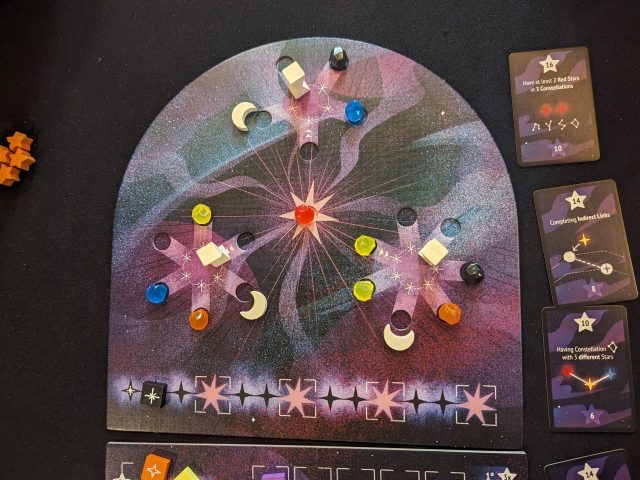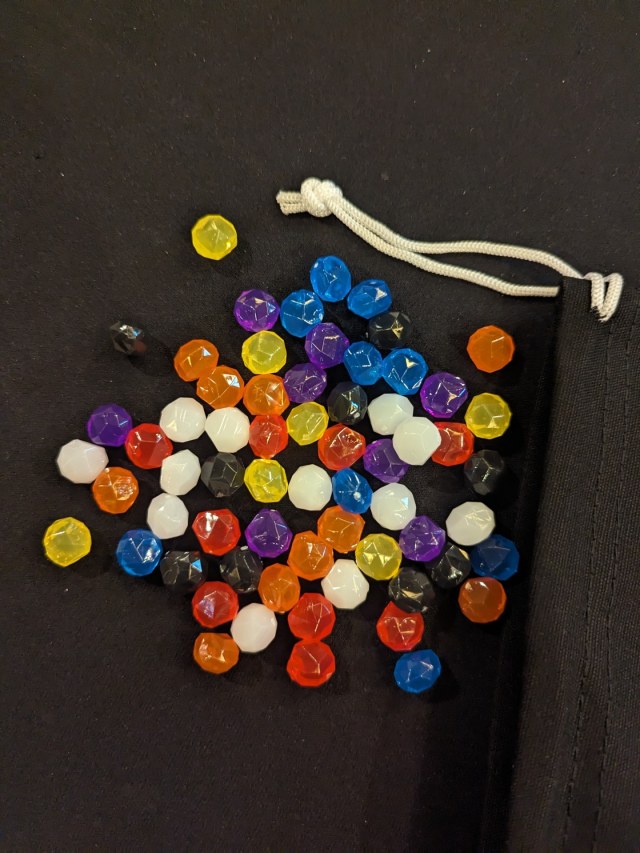Nebula
- Designers: Cristian Bustos and Bernardo Vasquez
- Publisher: Fractal Juegos
- Players: 2-4
- Age: 8+
- Time: 40 minutes
- Played with copy provided by publisher
It is said that for every person who has inhabited the Earth, there is more than one shining star in the universe… In Nebula you will have to collect stars to position them in your galaxy. Stars come in various stages, from red giants to white dwarfs, which you can get from star clusters. You can get stars by investing Time or going to Chaos. Then you must position them in some orbit and constellation respecting the law of gravity. Finally, there will be objectives, both personal and shared, that can reward you, and also some stars without glow that will remind us that death is part of stellar life. Give life to your Galaxy and find harmony within your constellations. The stories that will be invented while you watch them will last over time…
To set up the game, place the star cluster board on the table and fill in the three star clusters and the central Boosted star, drawing stars from the bag (which contains 6 different colors as well as black stars). A time indicator is placed around each cluster. The Values board is placed near the Cluster board, and the 14 Value tokens are placed in the appropriate starting spaces of the three tracks on that board. Four Race objective cards are drawn randomly as are four Advanced Objective cards.
Each player gets their own board which shows four different constellations ranged throughout five different orbits. There is a track for black stars at the top. Players are dealt 2 Personal Objective cards and they choose one for this game. Finally, based on turn order, players are given an initial number of random stars from the bag to place in their Observation area.
The game is played in rounds which continue until one of the four game-end conditions is met. On a player’s turn, four phases are always done in this order:
1] Collect Stars – two different ways to collect stars. First, you can use time – using 5 movement points to move any/all of the time indicators around the clusters and then taking the star from each cluster which is next to the indicator after the movement. Second, you can choose chaos. Discard one star from your Observation area, then draw 5 random stars from the bag, keeping two and discarding the other three. The gained stars, max 3 via time or 2 via chaos, are placed in your observation area.
2] Positioning Stars – you may place up to 2 differently colored Stars onto your personal board (though if you place a star matching the current Boosted Star, you can place 3). The first colored star of the game must go in your central space, then every colored star after that has to be connected to a previously placed star (by line or by orbit). Connected stars can never be of the same color. You can replace a previously placed star by simply discarding the old star and putting the new one it its place; however it must abide to all the placement rules.
Black stars have special rules and only are placed on your black star track at the top of the board. When you place a Black Star, you also move the marker forward on the chart underneath the Star Clusters, possibly changing the Boosted Star. You also move any Value Chip forward one space on the Value Chart. At the end of the game, the relative position of these markers will be used for scoring.
3] Check Objectives – Check to see if you have fulfilled a Race Objective. If so, place one of your markers on it to show completion. If you are the first to complete, place your marker at the top near the higher score. All other players who complete it take the lower score.
4] Refill the Star Clusters – if a Star Cluster is down to just 1 star, then refill that Cluster with stars drawn from the bag.
The next player then takes their turn. Play continues until one of the 4 end-game criteria is met: The Black Star track on the main board is completed, any player has completed three constellations on their board, the bag of Stars is empty, or enough Race Objective markers have been placed on the cards. the game ends at the conclusion of that round and moves into scoring.
Players calculate their scores:
- 14VP for a completed personal goal
- VPs for the Race goals which were completed
- VPs for the first visible number on the Black Star chart on the personal board
- VPs per completed constellation (the value of each can be modified by the Value Markers)
- 1-3VP per star placed based on color (due to position on Value Board)
- 2-4VP per advanced goal (again due to position on Value Board)
The player with the most points wins, ties broken in favor of the player with the most Black Stars placed.
My thoughts on the game
Nebula is an interesting puzzle game – well at least I consider it a puzzle game. You first have to figure out which start you are trying to grab, whether by manipulating the time markers or taking your chances to draw out of the bag, and then once you have them in hand, figuring out which ones are the best to play, and of course, the best places to play them in.
One thing that has come up in all of my games so far is that it is not easy to correctly follow the placement rules. The different star locations have multiple adjacencies, and it is not uncommon for a player to suddenly realize midway through the game that they have made a mistake and have two stars of the same color adjacent to each other. The long adjacency in the outer most orbit seems to be the most common offender here. There are a few spaces with 5 adjacencies – and as you can imagine, once you place a gem in this spot, it can really limit your options…
(in this example, I managed to screw up in Orbit 2 – with two yellows adjacent to each other – and we were to a point that it was impossible to undo it)
Or… once you’re through the learning phase, to realize that you won’t be able to accomplish one of the goals because you’ve blocked yourself from being able to place a particular color in a particular space.
The scoring board is also a very interesting mechanism, and one that gives you a lot to think about. There are only twelve total spaces on the black star chart, and there are 14 markers, so as you can imagine, there really isn’t a lot of movement on these tracks, and as a result, each forward step is a big deal. The player who makes the move must also consider that they lose the opportunity to place a colored star on their own board. Since all players can take advantage of the increased scoring, you’d like to find a score marker move that benefits you more than everyone else since you are giving up placement on your board. (Yes, I know that you score some points for each placement on your personal black star track…)
While you are considering which stars to take, which stars to place, you also need to watch the objectives – with one personal and four race objects in play as well as up to four of the advanced goals that are dependent on score marker movement… It can be a lot to think about, though interestingly I have found that this has not really led to Analysis Paralysis, perhaps because there are so many things to consider that players stop trying to perfectly optimize a play and instead just choose what they are trying to do and move towards that. I will note that the 14VP return for the personal goal is a really big number, and I’m hard pressed to ignore this opportunity.
Once the learning curve has been maneuvered through, our games are now around 30 minutes which makes this a really good super-filler. There is a nice game here compressed into that half an hour; and the changing goals and objectives force you to approach the game slightly differently each time. All of my games thus far have ended due to a player completing constellations on their board, but the star bag has almost run out as we now tend to draw from the bag more than before.
Ratings from the Opinionated Gamers
- I love it!
- I like it. Dale
- Neutral.
- Not for me…


